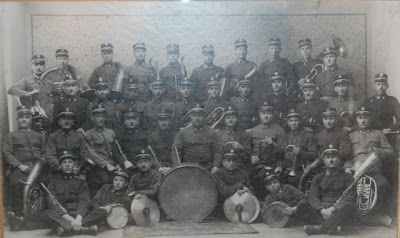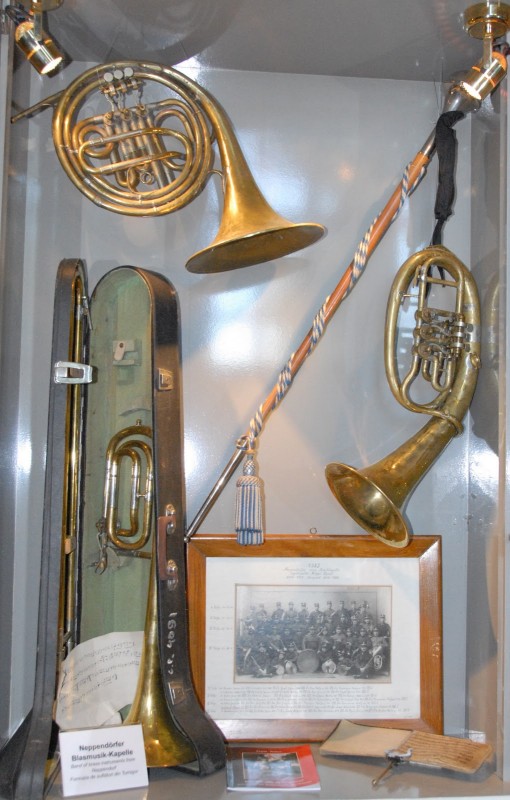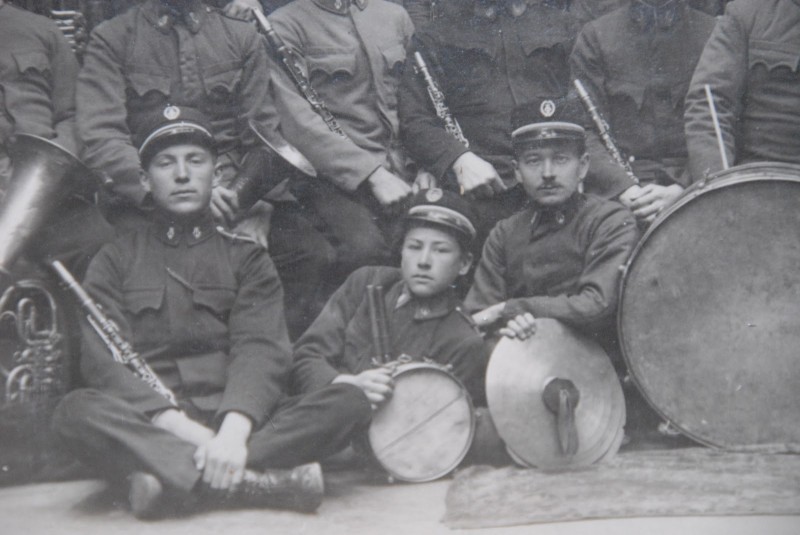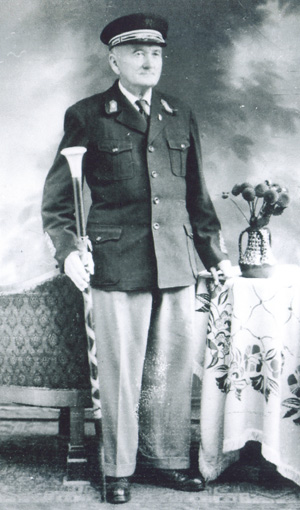
Marching Band of Neppendorf – 1925
“Neppendörfer Neue Musikkapelle”
Michael Gärtz, bottom row, 3rd from left
Travel Tuesday
When we walked into the small museum at the back of my grandfather’s Lutheran Church in Neppendorf (near Sibiu) and found photos of my grandmother and grandfather’s sister on display, we realized how interwoven our family history was with this community. The same images we cherished in our own collection at home were here, 5,000 miles distant from Chicago, helping others to understand the culture of the Siebenbürgen Germans. (See last Travel Tuesday Post: Spilling Secrets).
But the museum highlighted a Gärtz my brothers and I had never known.
Although Josef Gärtz had struck out for America in 1910, the family of his half-brother (born in 1867) stayed for the next 70 years in Neppendorf, where the Gärtz name became inextricably bound to the town’s famous marching band.
The church museum dedicates several displays to the band, including this one with instruments, uniforms, and a 1925 photo, entitled Neppendorfer Neue Musikkapelle, The New Neppendorf Band (see above).
No man is more associated with this famous band than my grandfather Josef’s, nephew, Michael Gärtz. He was the son of Josef’s twenty-two-year-older half brother. Born in 1893, Michael was a mere four years younger than his Uncle Josef. You’ll see my grandfather’s nephew, Michael Gärtz, in the photograph bottom row, third from left, at the age of thirty-two.
Michael was drawn to music at an early age. The twentieth century was barely new when, at the age of nine, he joined the Neppendörfer Blaskappelle (brass band), first playing the drums, then the Flügelhorn, an instrument similar to a trumpet.
The band was an integral part of the community, playing at weddings, festivities, holidays, and parades. Michael rose to become one its longest-serving leaders. Just one year after the group picture above was taken, in 1926, he was made conductor, a position he held for the next forty-five years.
At the end of the Second World War, about 75,000 ethnic Germans were deported from Transylvania to Soviet labor camps. In 1946, Michael Gärtz’s job was to revitalize the band and somehow bring spirit back to a community that had lost virtually an entire generation.
He did it with passion and verve, leading the band to capture first prize in 1951 as best marching band in Romania, and in 1960, second prize. For a community that needed an injection of hope and positive creativity after the devastation of the Second World War, Michael gave his town a shot of joy and pride. Here is the conclusion of the eulogy for him I found online, written by a fellow townsman, Ervin Köber. I translated his words from the original German:
“For his entire life, Michael Gärtz championed the musical cultural life in Neppendorf. The marching band was strengthened under his leadership and the quality of its music reached a distinguished high point. Michael Gärtz is among the most famous music teachers of Neppendorf and Hermannstadt in the second half of the 20th century.”
See photos and hear music of the Neppendorf Marching Band on You Tube.




I’ve often wondered how families and communities survived the brutality of Stalin and Soviet rule. Music absolutely helped my own family cope. Your cousin’s life is another beautiful example of human endurance and music’s power.
OK — I’m confused. Your family was ethnic German, right? How did they avoid deportation by the Russians?
Marching bands are great for the soul. I’ve seen the Flugelhorn on only one occasion.
I’ve awarded you the One Lovely Blog Award! Please visit my blog at http://www.2338wwashingtonblvd.blogspot.com/ to pick up your award!
Thanks to all for your comments. Kathy, there is a family story involved with how the Gärtz family avoided deportation (and expropriation of their property, as happened to so many). I’ll be talking to my cousin Maria, and her father to try to get a better idea why they were among the lucky ones (not every single German was sent to Russian labor camps, but tens of thousands were. Here’s a quote from a Wikipedia site (not always perfect sources, so more citations need to be added, but provides an overview: “The expulsion of Germans from Romania after World War… Read more »
Kathy Reed posed the question as to why the Gärtz family wasn’t deported to Russia after World War II (see above). Here’s what my cousin, Maria, granddaughter to Michael Gärtz, subject of this post, told me:
“My father was too young [to be sent] and Grandfather [Michael] was “Unteroffizier” [a non-commissioned officer or perhaps corporal] in the Romanian Military band. Therefore, he wasn’t sent because he was important for the country, even if only in the role of a military musician!”